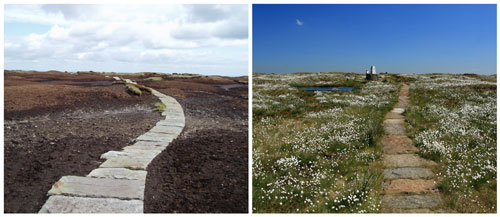Moors for the Future

 The Moors for the Future Partnership works on the Peak District and South Pennine moors to improve their condition.
The Moors for the Future Partnership works on the Peak District and South Pennine moors to improve their condition.
The Partnership has three objectives:
- To raise awareness of why the moors are valuable and to encourage responsible use and care of the landscape
- To protect and conserve important recreational and natural moorland resources
- To develop expertise on how to protect and manage the moors sustainably.
High on the moors of the Peak District is a landscape of peat, a rich, dark soil. Peat is formed when plants, including peat-forming Sphagnum mosses, decay slowly in waterlogged conditions. Instead of rotting away, this peat gradually builds up over thousands of years. Healthy blanket bogs are covered in a patchwork of specialist plants which provide benefits to the surrounding area because:
- they help keep peat on the moors and out of water flowing into reservoirs, resulting in cleaner water (and lower water bills!)
- they can slow water down when it rains heavily, helping to reduce flooding in the valleys below
- they take in carbon dioxide from the air and turn it into peat (and prevent loss of carbon through erosion and oxidation)
- they provide food, shelter and a home for many special animal species like curlew, red grouse, mountain hare, common lizard and short-eared owl.
Moors for the Future Partnership aims to reverse historic damage to the moorland plants, in which air pollution and wildfire killed off huge areas of vegetation. This resulted in expanses of bare peat, which has no vegetation on it, leaving it vulnerable to wildfire and erosion. The worst of this damage occurred in the Industrial Revolution, when smoke from factories in the surrounding cities caused by air pollution.
Our work includes:
- Planting native moorland species to re-establish plant cover. This makes the moors less vulnerable to erosion, and provides a place where upland wildlife can thrive. It helps to reduce the amount of peat being carried off the hills into streams, rivers and reservoirs.
- Planting native trees in cloughs (in steep-sided valleys) which have been lost over time. Clough woodlands help improve water quality by stabilising soil as well as providing a habitat for woodland species.
- Improving rights of way on the moors to repair and prevent erosion of the soil, and to encourage walkers to stick to one route so that the surrounding wildlife will not be disturbed.
- Re-wetting the moors by planting Sphagnum moss and blocking erosion gullies, formed because bare peat was washed away by rainwater, with small dams. It also helps to prevent wildfire and create a better environment for a blanket bog to flourish.
- Building up a body of evidence to help understand how well moorland conservation techniques work. We work alongside several universities and PhD students.
- Using citizen science volunteers to record and monitor upland plants and animals, to help understand how climate change is affecting upland species.
- Sharing our enthusiasm through a programme of events and talks to inspire people about just how brilliant blanket bogs are, inform them about the benefits they provide, and explain the story of the recovery of the moors from bare peat to revegetated, healthy blanket bog.
For more information visit www.moorsforthefuture.org.uk.


